Study of Prevention and Control Technology for Roadway Excavation under the Soft and Extra-Thick Coal Roof in Luling Coal Mine
Abstract
:1. Introduction
2. Numerical Simulation Calculation
2.1. Engineering General Situation
2.2. Establishment of a Calculation Model
2.3. Analysis of Numerical Results
2.4. Analysis of Numerical Results
2.4.1. Analysis of the zz-Stress Field
2.4.2. Analysis of the xx-Stress Field
2.4.3. Analysis of the xz-Stress Field
2.4.4. Development and Evolution of the Plastic Zone in the Rock Surrounding the Roadway
3. Study of Coal Wall Water Injection to Prevent Splicing
3.1. Mechanism to Modify Coal Wall Water Injection
3.2. Determination of Water Injection Parameters
3.2.1. Determination of Moisture Content of Coal
3.2.2. Water Injection Depth
3.2.3. Water Injection Hole Layout
4. Industrial Test
4.1. Metal Roof Skeleton
- (1)
- The two sides of the three-cores arch formed by the U-shaped shed beam were placed in the roadway side coal seam so that the top of the U-shaped shed beam was in contact with the coal seam. The two sides of the U-shaped shed beam were set in the rock stratum to improve the stability.
- (2)
- In the roof coal seam, the advanced skeleton anchor bolt was driven under its cover as support. The length of the advanced skeleton anchor bolt was 3 m per section. The specific requirements were as follows: The layout position of the advance skeleton anchor bolt was closed to the top of the head-on U-shaped shed beam, and the construction was carried out using an air drill, an anchor drill, and an air hammer. The spacing between the advanced skeleton anchor bolts was 100~150 mm. The skeleton angle and direction of all advanced skeleton anchor bolts were consistent to ensure that a plane was formed which was at an angle of 3~5° to the roadway roof. After construction with the advance skeleton anchor bolts was completed, the steel belt and anchor cable were used at its tail end for reinforcement, and the angle between the anchor cable and the advanced skeleton anchor bolt was 65~80°. When the advanced skeleton anchor bolt was erected forward, the U-shaped shed beam should be close to the upper metal skeleton. After construction of the stubble pressing position, the construction of the metal skeleton for the next section was carried out again under the adjacent U-shaped shed beam at the head, and the two adjacent U-shaped shed beams were erected by descending 150~200 mm in turn. Each group of advanced skeleton anchor bolts were constructed in a cycle of four sheds, and the steel belt and anchor bolts were used for secondary reinforcement between the third and the fourth sheds. The depth of the anchor end of the anchor cable into the stable rock stratum was not less than 1.5 m, and the row spacing between the anchor cables was 1200 mm × 1200 mm (split layout). The layout of the anchor rod, the anchor cable, and the steel belt with the advanced metal skeleton is shown in Figure 11.
4.2. Support Effect Evaluation
5. Conclusions
- (1)
- Based on numerical calculation, the central area of the roof and floor after roadway excavation was found to be the pressure relief area, and the stress concentration area appeared in the two bottom angles and sidewalls. The side showed asymmetric characteristics because of the influence of the coal seam dip angle.
- (2)
- From tests of the coal in the Luling coal mine, the moisture content of the coal was found to be 3.858%, which did not reach the optimum moisture content. The strength of coal could therefore be improved by appropriate water injection.
- (3)
- According to the engineering geological characteristics of the Luling coal mine, the construction technologies of water injection, metal steel pipe roof protection, and shed support were proposed, which enhanced the roof stability and accelerate the tunneling efficiency.
- (4)
- Site monitoring of the surrounding rock of roadway after support showed a maximum roof deformation of 24.8 mm. The two-side displacement was 21.5 mm. These data indicated that the surrounding rock deformation was in the safe range.
Author Contributions
Funding
Data Availability Statement
Conflicts of Interest
References
- Cui, F.; Zhang, T.; Cheng, X. Research on Control of Rib Spalling Disaster in the Three-Soft Coal Seam. Shock Vib. 2021, 2021, 2404218. [Google Scholar] [CrossRef]
- Yuan, Y.; Zhu, C.; Wei, H. Study on rib spalling control of short wall drilling mining technology with a large mining height. Arab. J. Geosci. 2021, 14, 164. [Google Scholar] [CrossRef]
- Li, Z.H.; Shen, W. Sloughing mechanism and control of coal wall in high cutting fully-mechanized top coal caving mining face in ultra-thick seam. Coal Sci. Technol. 2016, 44, 45–51. [Google Scholar]
- Jin, Z.Y.; Zhang, Y.D.; Gao, L.S. Prevention Measures for Rib Spalling at Large Mining Height Working Face. Saf. Coal Mines 2013, 2013, 220–222. [Google Scholar]
- Likar, J.; Medved, M.; Lenart, M.; Mayer, J.; Malenković, V.; Jeromel, G.; Dervarič, E. Analysis of geomechanical changes in hanging wall caused by longwall multi top caving in coal mining. J. Min. Sci. 2012, 48, 135–145. [Google Scholar] [CrossRef]
- Li, S.H.; Zhang, F.C.; Zhang, Z. Design optimization of flat roof micro arch section of long-span coal roadway in Mengxi deep mine. Coal Technol. 2019, 38, 20–23. [Google Scholar] [CrossRef]
- Huang, X.W.; Yao, Z.S.; Cai, H.B.; Li, X.W.; Chen, H.Q. Performance evaluation of coaxial borehole heat exchangers considering ground non-uniformity based on analytical solutions. Int. J. Therm. Sci. 2021, 170, 107162. [Google Scholar] [CrossRef]
- Liu, S.; Yang, K.; Zhang, T. Rib Spalling 3D Model for Soft Coal Seam Faces with Large Mining Height in Protective Seam Mining: Theoretical and Numerical Analyses. Geofluids 2020, 2020, 8828844. [Google Scholar] [CrossRef]
- Li, C.; Kang, T.; Li, X. Theoretical Investigation of the Sliding Instability and Caving Depth of Coal Wall Workface Based on the Bishop Strip Method. Adv. Civ. Eng. 2019, 2019, 3065930. [Google Scholar] [CrossRef]
- Fu, Y.G.; Li, Y.M.; Xu, X.S. Study on Mechanism of Rib Spalling in Large Cutting Height Rise Mining Face in Soft Thick Seam. Coal Sci. Technol. 2014, 42, 15–18. [Google Scholar]
- Wang, J.C. Mechanism of the rib spalling and the controlling in the very soft coal seam. J. China Coal Soc. 2017, 32, 785–788. [Google Scholar]
- Yang, K.; He, X.; Liu, S.; Lu, W. Rib spalling mechanism and control with fully mechanized longwall mining in large inclination “three-soft” thick coal seam under closed distance mined gob. J. Min. Saf. Eng. 2016, 33, 611–617. [Google Scholar]
- Guo, J.S.; Ma, L.Q.; Wang, Y.; Wang, F.T. Hanging Wall Pressure Relief Mechanism of Horizontal Section Top-Coal Caving Face and Its Application-A Case Study of the Urumqi Coalfield. Energies 2017, 10, 1371. [Google Scholar] [CrossRef]
- Liu, Z.G.; Cao, A.Y.; Guo, X.S.; Li, J.X. Deep-hole water injection technology of strong impact tendency coal seam—a case study in Tangkou coal mine. Arab. J. Geosci. 2018, 11, 12. [Google Scholar] [CrossRef]
- Liu, Z.; Wang, W.Y.; Yang, H.; Yu, S.J.; Xin, L. Experimental Study on the Fractal Pattern of a Coal Body Pore Structure Around a Water Injection Bore. J. Energy Resour. Technol. 2020, 142, 012302. [Google Scholar] [CrossRef]
- Yan, J.J.; Wang, F.; Li, Y.C.; Gao, Y.B.; Li, Z.G.; Liu, H.W. A Feasibility Study of Coal Seam Water Injection Processes: The Effects of Coal Porosity and Mass Flow Rates of Injected Water on Wetting Radii. Energy Fuels 2020, 34, 16956–16967. [Google Scholar] [CrossRef]
- Yang, R.; Zhu, Y.; Zhu, X. Discussions on Some Security Mining Problems of Fully-Mechanized Top Coal Mining in “Three Soft” Large Inclined Angle Working Face. Procedia Eng. 2011, 26, 1144–1149. [Google Scholar]
- Liu, C.Y.; Zhao, G.M.; Xu, W.S.; Meng, X.R.; Huang, S.J.; Zhou, J.; Wang, Y.K. Experimental investigation on failure process and spatio-temporal evolution of rockburst in granite with a prefabricated circular hole. J. Cent. South Univ. 2020, 27, 2930–2944. [Google Scholar] [CrossRef]
- Chen, W.M.; Nie, W.; Zhou, G.; Yu, Y.B.; Ma, Y.Y.; Xue, J. Research and practice on fluctuation water injection technology at low permeability coal seam. Saf. Sci. 2012, 50, 851–856. [Google Scholar] [CrossRef]
- Dong, L.J.; Chen, Y.C.; Sun, D.Y.; Zhang, Y.H. I Implications for rock instability precursors and principal stress direction from rock acoustic experiments. Int. J. Min. Sci. Technol. 2021, 31, 789–798. [Google Scholar] [CrossRef]
- Perera, M.S.A.; Ranjith, P.G.; Choi, S.K.; Bouazza, A. A parametric study of coal mass and cap rock behavior and carbon dioxide flow during and after carbon dioxide injection. Fuel 2013, 106, 129–138. [Google Scholar] [CrossRef]
- Wei, J.P.; Jiang, W.; Si, L.L.; Xu, X.Y.; Wen, Z.H. Experimental research of the surfactant effect on seepage law in coal seam water injection. J. Nat. Gas Sci. Eng. 2022, 103, 104612. [Google Scholar] [CrossRef]
- Wang, G.; Wang, E.M.; Huang, Q.M.; Li, S.P. Effects of cationic and anionic surfactants on long flame coal seam water injection. Fuel 2022, 309, 122233. [Google Scholar] [CrossRef]
- Hao, J.Y.; Hu, X.M.; Zhao, Y.Y.; Shao, Z.; Cheng, W.M.; Zhu, S.C.; Song, C.Y.; Zhu, F.S. Improvement of wettability of coal seams in water injection via co-deposition of polydopamine and polyacrylamide. Colloids Surf. A Physicochem. Eng. Asp. 2022, 636, 128112. [Google Scholar]
- Sun, J.; Zhou, G.; Wang, C.M.; Liu, R.L.; Miao, Y.N. Performance comparison analysis of high-efficiency wetting enhancers for coal seam water injection. Process Saf. Environ. Prot. 2021, 147, 320–333. [Google Scholar] [CrossRef]
- Wei, K. Study on Prevention Technology of Rib Spalling of Coal Wall Water Injection in “Three Soft” Thick Coal Seam. Master’s Thesis, China University of Mining and Technology, Beijing, China, 2018. [Google Scholar]
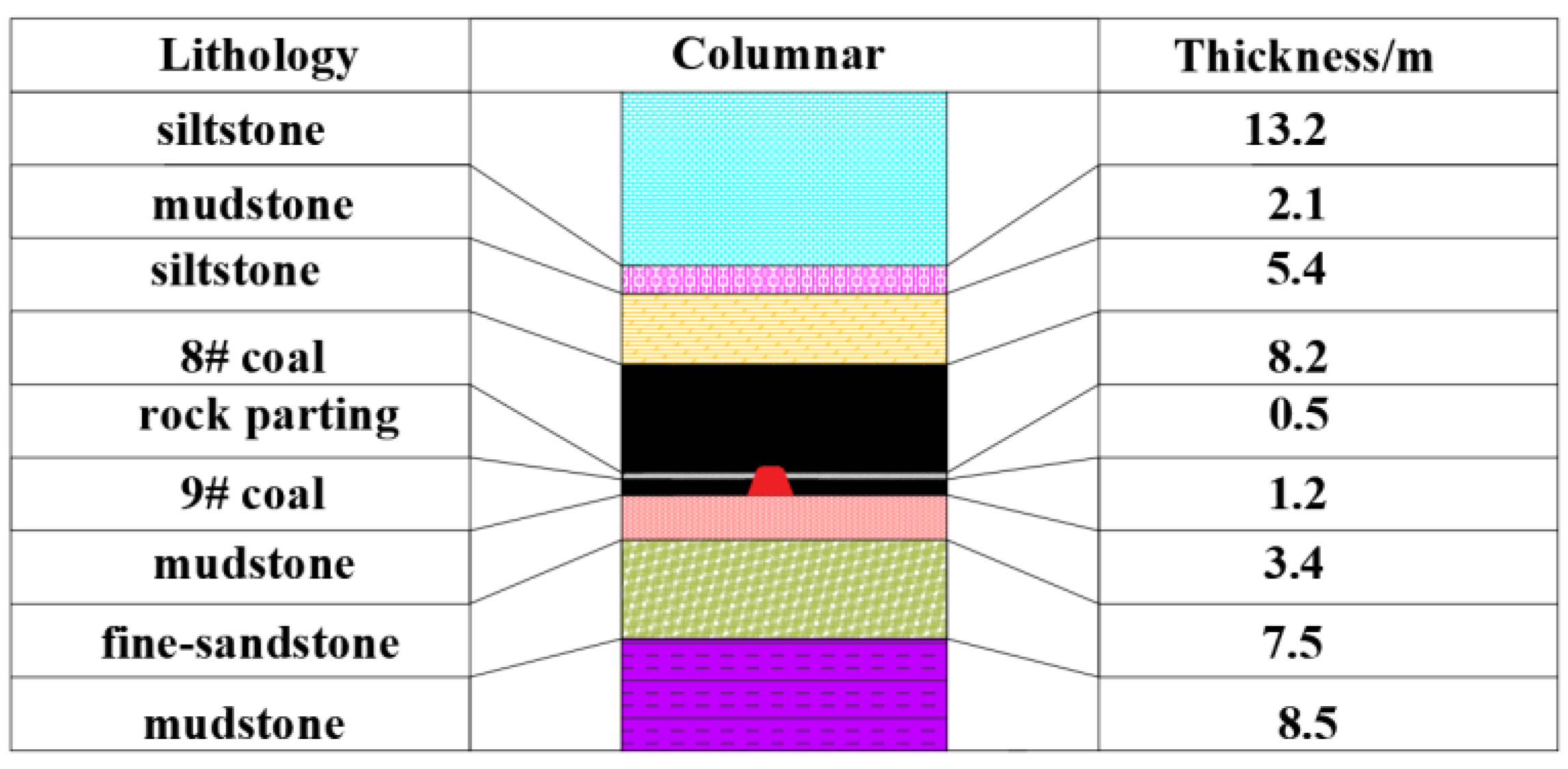





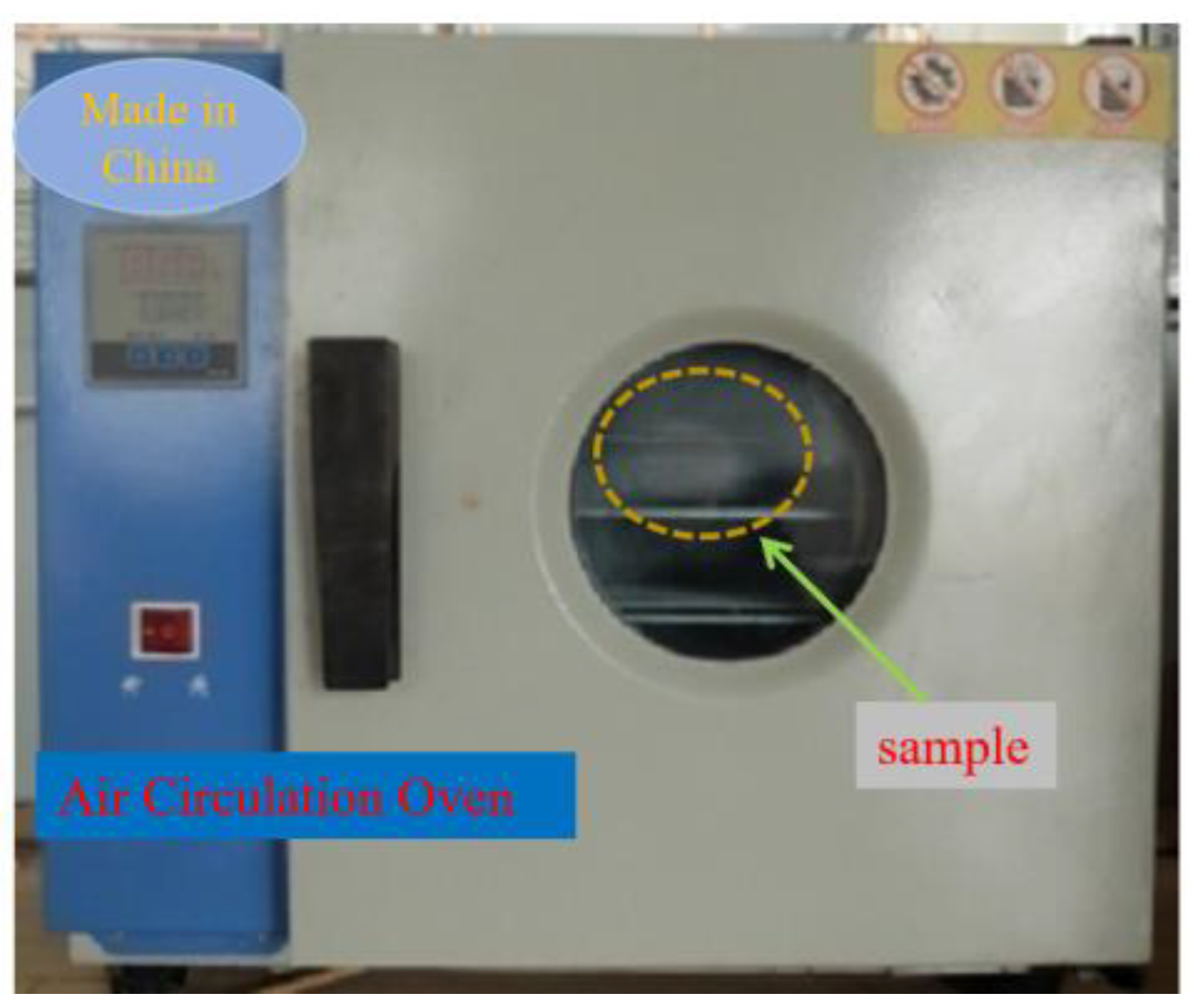

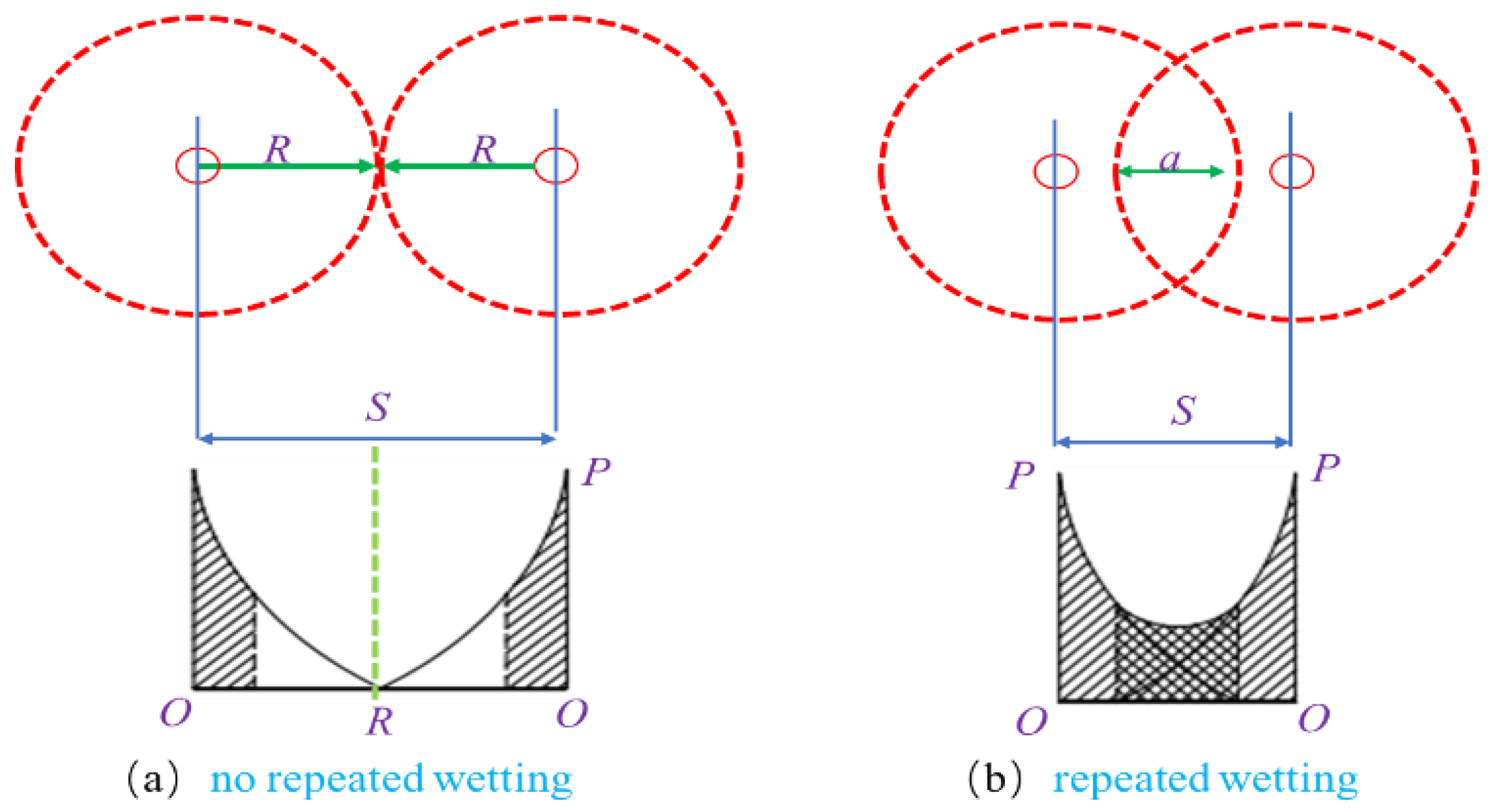
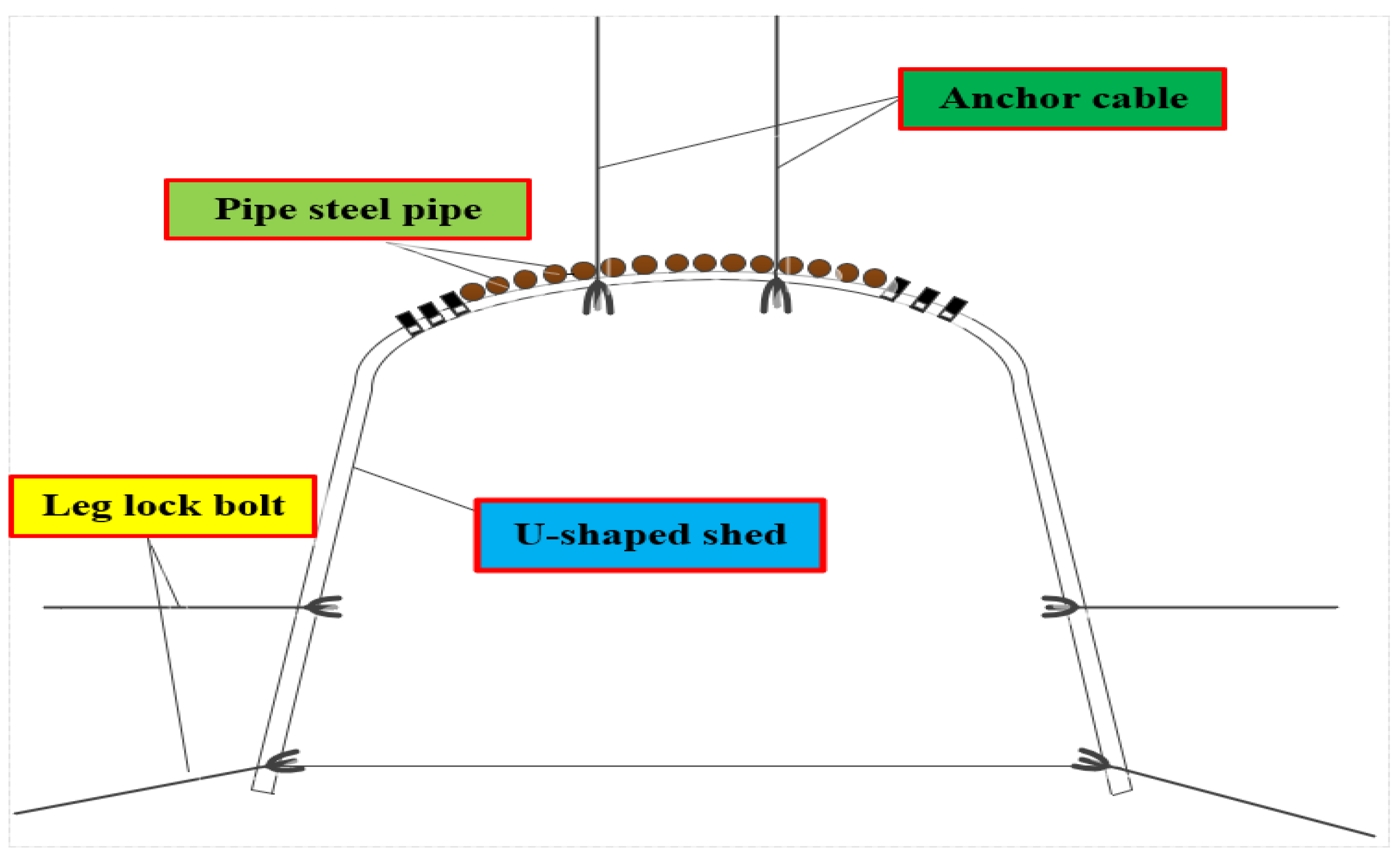
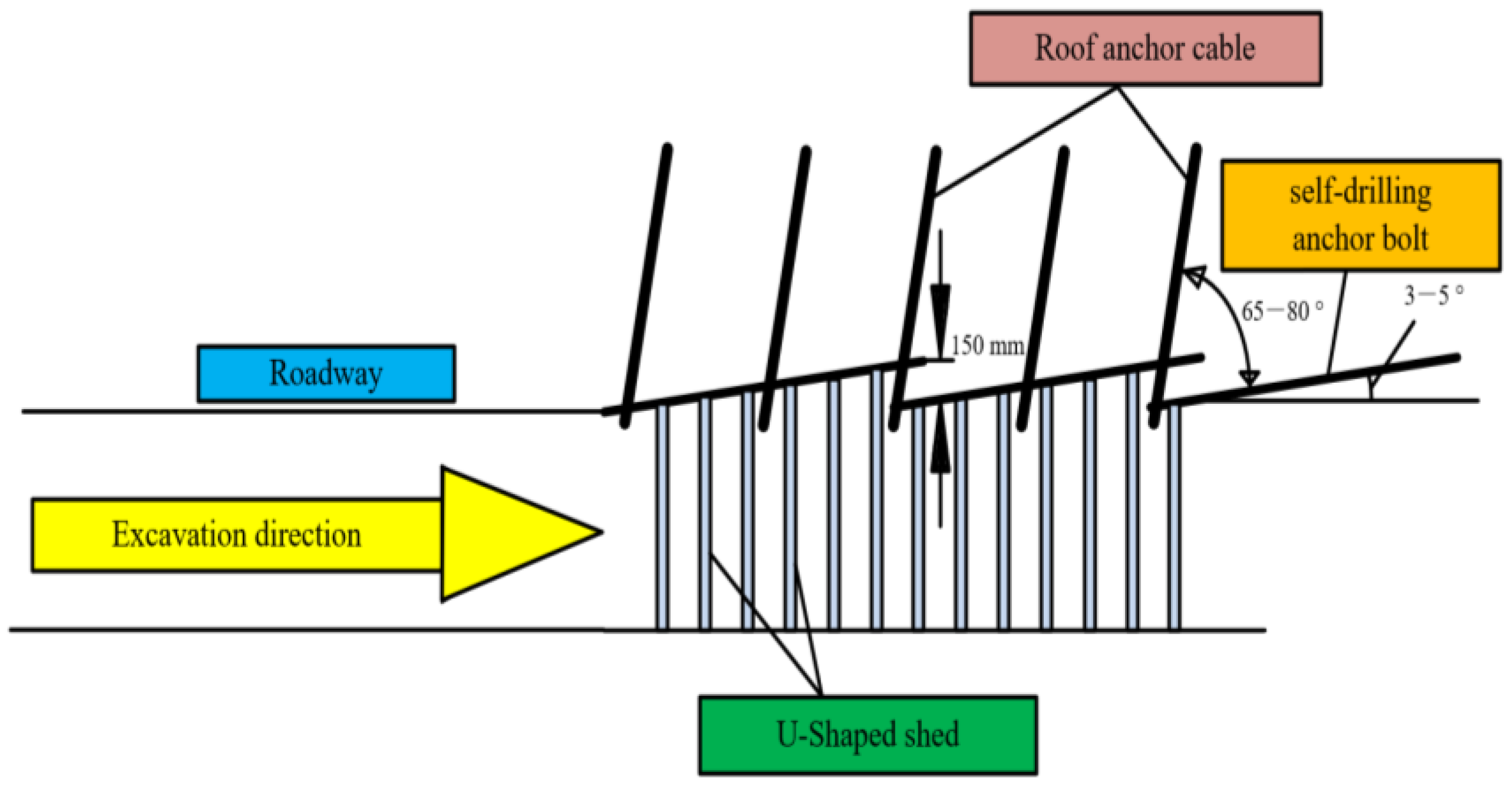
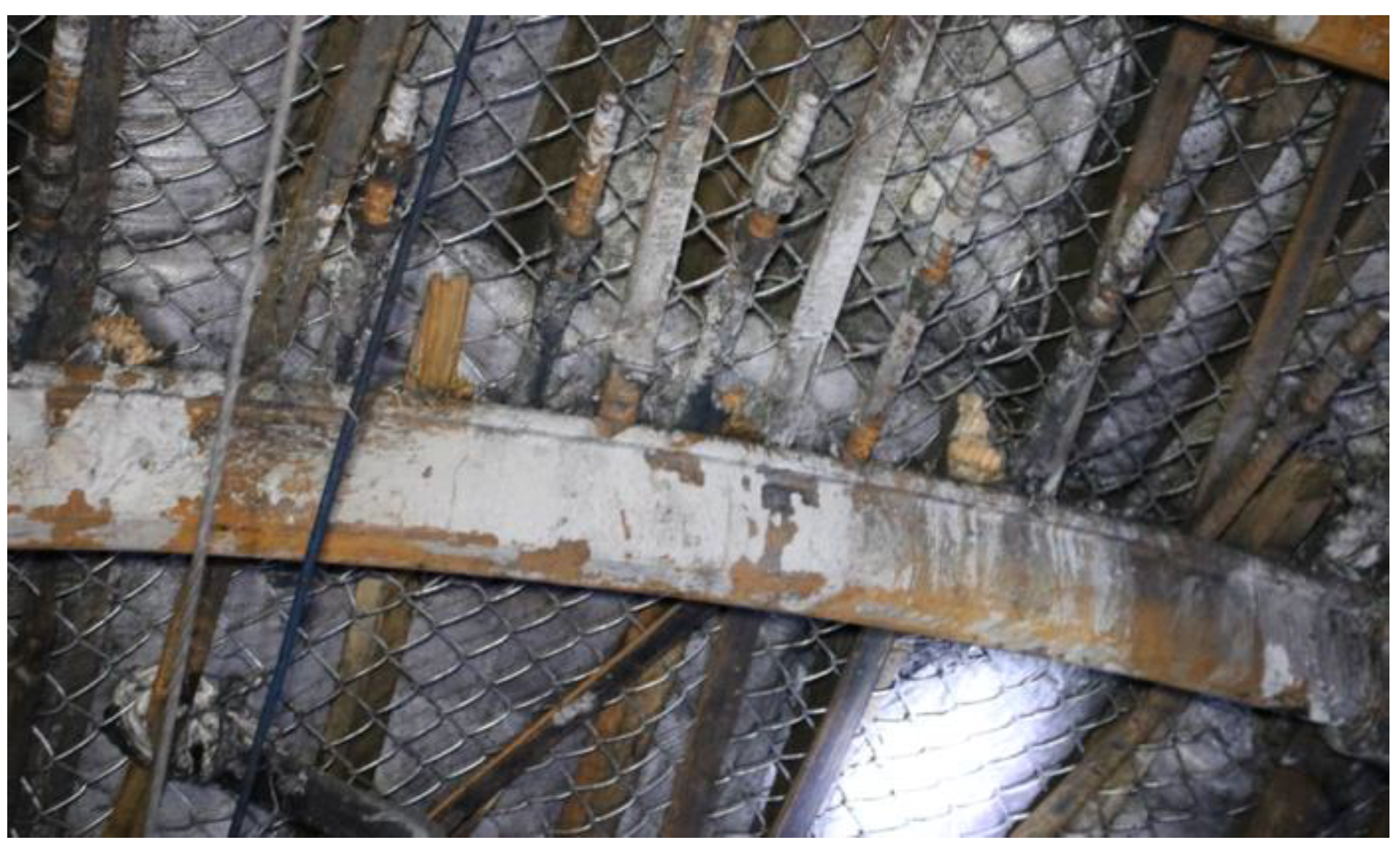
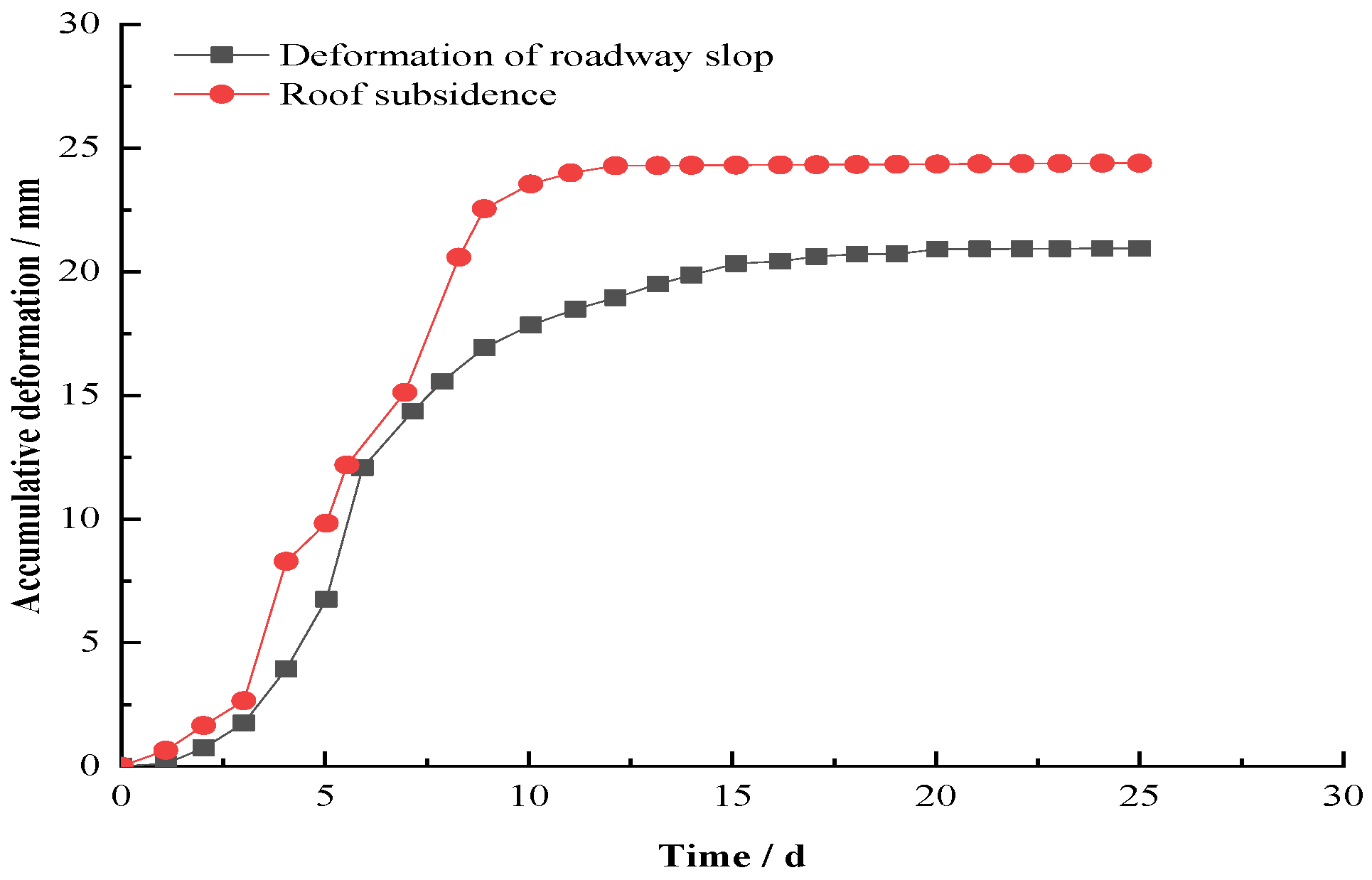

| Lithology | Bulk Modulus /GPa | Elastic Modulus /GPa | Cohesive /MPa | Internal Friction Angle/° | Tensile Strength /MPa | Volumetric Weight /N·m−3 |
|---|---|---|---|---|---|---|
| Sandstone | 1.333 | 1.000 | 2.78 | 36 | 2.20 | 2673 |
| Mudstone | 6.080 | 3.470 | 1.2 | 29.8 | 0.61 | 2261 |
| Siltstone | 1.083 | 8.125 | 2.75 | 38 | 1.84 | 2461 |
| Fine-sandstone | 2.210 | 1.153 | 2.5 | 32 | 2.40 | 2730 |
| 8# and 9# coal | 4.294 | 2.702 | 1.25 | 32 | 1.15 | 1380 |
Publisher’s Note: MDPI stays neutral with regard to jurisdictional claims in published maps and institutional affiliations. |
© 2022 by the authors. Licensee MDPI, Basel, Switzerland. This article is an open access article distributed under the terms and conditions of the Creative Commons Attribution (CC BY) license (https://creativecommons.org/licenses/by/4.0/).
Share and Cite
Huang, S.; Zhao, G.; Meng, X.; Cheng, X.; Xu, W.; Liu, G.; Zhu, S. Study of Prevention and Control Technology for Roadway Excavation under the Soft and Extra-Thick Coal Roof in Luling Coal Mine. Processes 2022, 10, 1835. https://doi.org/10.3390/pr10091835
Huang S, Zhao G, Meng X, Cheng X, Xu W, Liu G, Zhu S. Study of Prevention and Control Technology for Roadway Excavation under the Soft and Extra-Thick Coal Roof in Luling Coal Mine. Processes. 2022; 10(9):1835. https://doi.org/10.3390/pr10091835
Chicago/Turabian StyleHuang, Shunjie, Guangming Zhao, Xiangrui Meng, Xiang Cheng, Wensong Xu, Gang Liu, and Shikui Zhu. 2022. "Study of Prevention and Control Technology for Roadway Excavation under the Soft and Extra-Thick Coal Roof in Luling Coal Mine" Processes 10, no. 9: 1835. https://doi.org/10.3390/pr10091835





